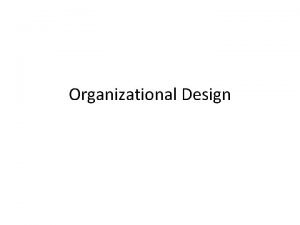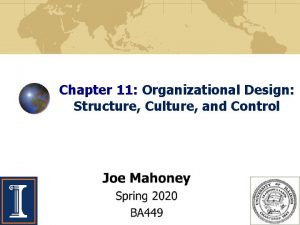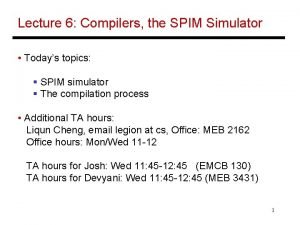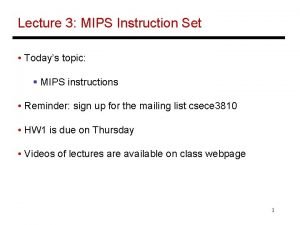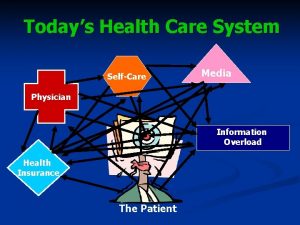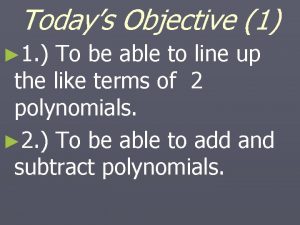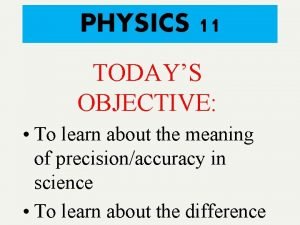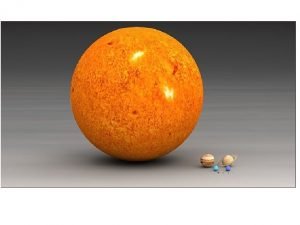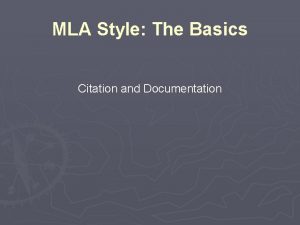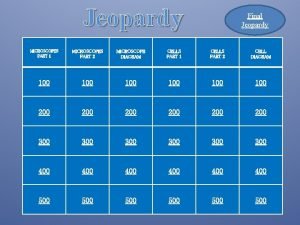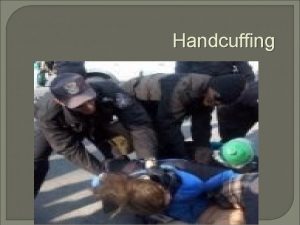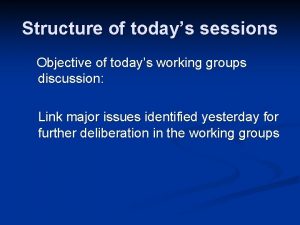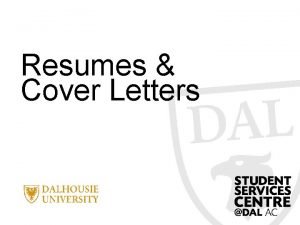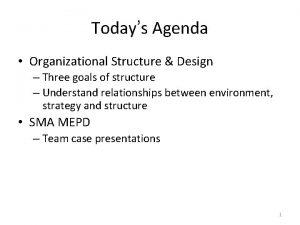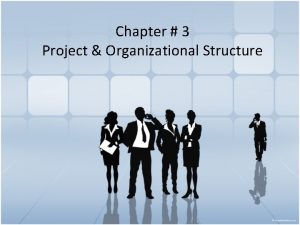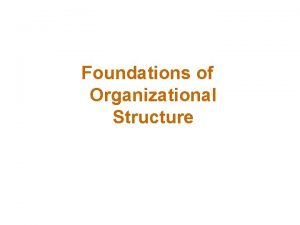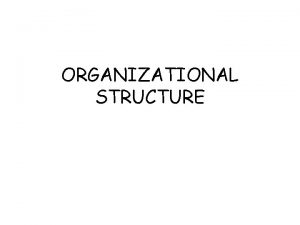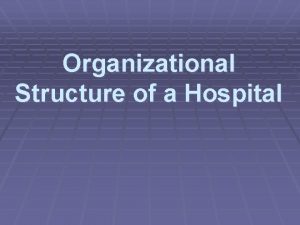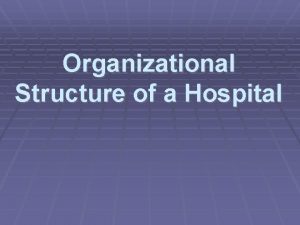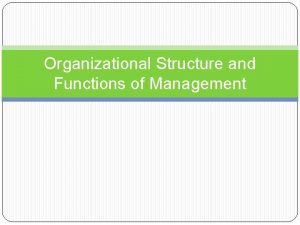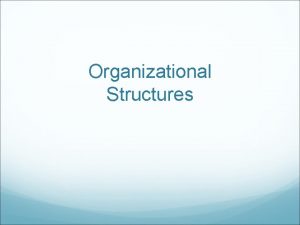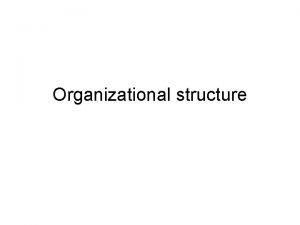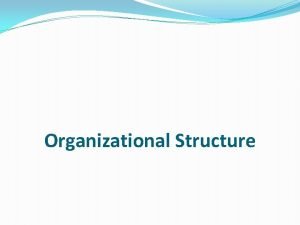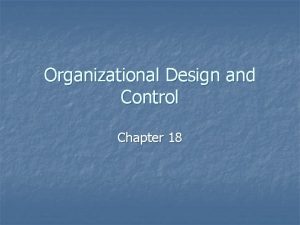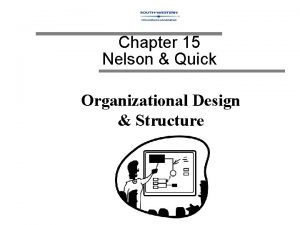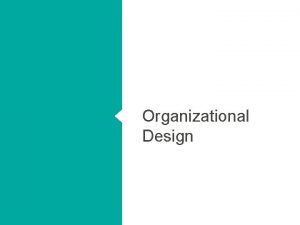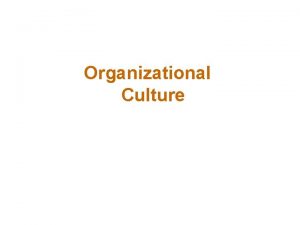Organizational Design Todays Agenda Organizational Structure Design Three



































- Slides: 35

Organizational Design

Today’s Agenda • Organizational Structure & Design – Three goals of structure – Understand relationships between environment, strategy and structure • SMA MEPD 2

Open Systems Model Transformation Processes Inputs Interactions of: Environment • Formal Org Strategy • Informal Org • Tasks Resources • Individuals History Outputs Individual behavior Group behavior Organizational functioning Feedback 3

The Three Goals of Structure • Efficiency – minimize costs, time, effort • Coordination – coordinate diverse organizational tasks – ease information flow • Adaptability/Flexibility – scan environment – change to meet environmental needs 4

Structural Design Dimensions of Organizations • (Structural) Differentiation: How are activities divided? – Vertical differentiation (hierarchy of authority) – Horizontal differentiation (specialization, e. g. product, process, function, geography) – Complexity (number of activities or subsystems) • Integration: How are activities coordinated/linked? – – Centralization (hierarchical level of decision making) Span of control (# of products, processes, functions supervised) Formalization (amount of written documentation) Standardization (degree similar work is done in uniform manner) 5

Issues in Differentiation of Subsystems • • Differences in time orientation Differences in objectives Differences in interpersonal orientation Differences formal structure Divisional (Product or Market, etc. ) Structure President Product Group 1 R&D Mfg Acct Product Group 2 Mkt R&D Mfg Acct Product Group 3 Mkt R&D Mfg Acct Mkt 6

Structural Integrating Mechanisms 7

Non-structural Integrating Mechanisms 8

Degree of Vertical Coordination and Control Required Vertical Linkages Vertical information systems High Add positions to hierarchy Rules and plans Hierarchical referral Low High Information Capacity of Linkage Mechanism 9

Horizontal Linkages High Degree of Horizontal Coordination Required Teams Full-time integrators Task forces Liaison roles Direct contact Information Systems Low High Costs of Coordination 10

Ø Designing Organizations is the process of purposefully configuring the elements of the organization to foster the achievement of valued business, customer, and employee, community and environmental outcomes. SM 14 J(11)

Design at All System Levels Inter-Organizational Corporate/ System Wide Business Unit Inter-Unit Team, Work Unit, or Work Process SM 22 I(12)

Why is organization design important? Ø Ø Ø Ø Resources are aligned or misaligned with strategy and priorities. Coordination is efficient or inefficient—resource use is optimized or resources are wasted. Performance capabilities are enabled or disabled—quality, speed, innovation, growth Work is hard or easy to do—people are frustrated or feel well utilized. Customer interfaces are effective or ineffective—high value is delivered or not. Human capital is developed, motivated, and retained or stagnates, becomes cynical and “departs”. Societies, communities, and ecologies are strengthened or depleted SM 194 P(13)

Learning Two: Organizations are designed to fit a context, not a recipe (14)

Strategy Star Model Work Processes/ Capabilities People Structure Management Processes Rewards Behavior Performance Culture Adapted from: J. Galbraith SM 107 T(15)

Self-Design and the Star Strategy Laying the Foundation Valuing Acquiring Knowledge Diagnosing W P S R C R I T E R I A Designing W P S R Implementation & Assessment M M SM 106 T (16)

Learning Three: Hierarchical structure is necessary but insufficient in a dynamic and complex environment. (17)

Hierarchical, Functional Organization General Manager Director of Engineering Manager Software Engineer etc. Manager Hardware Engineer Director of Marketing Manager Tech Support etc. QA Manager QA Specialist Manager Product Marketing QA Specialist Director of Manufacturing Manager Marketing Support Manager Mfg Engineer Administrative Director Manager Operations etc. Manager HR etc. Testing Manager Mfg QA Manager Training Specialist etc. Manager Info Systems etc. Comp & Benefits Manager Mfg Testing Manager etc. Finance Manager Comp. Specialist Benefits Specialist Comp. Analyst SM 34 I(18)

Team-Based Organization Executive Team Process Teams Councils Shared Services Team Leadership Team Business Unit 1 Process Team Team Leadership Team Business Unit 2 Cross Unit Opportunity Teams Process Team Team SM 50 T(19)

Networks Executive Team Integrating Councils Shared Services Management Team Unit 1 Integrating Teams Team SM 33 M Team Management Team Unit 2 Opportunity Team Knowledge Network (20) Integrating Teams Team

Common Aims of Internal Restructuring • Enhance flow of information and expertise across organizational boundaries to increase: – Learning – Catching Mistakes – Innovation – Efficiency – Shared Understanding – Coordination

Implement the Internal Restructuring • Over communicate honestly • Align goals with the restructuring Efforts • Avoid the creation of bottle-necks that require certain people to be brokers • Involve employees in the process and take their input into account • Create a climate that supports speaking up in order to enhance the flow of information resources across organizational boundaries.

Managing Internal Change: Downsizing • Downsizing= Layoffs + Restructuring • Given economic weakness, majority of CEOs report the need to reduce staff amid continued economic weakness and tight profit margins • More than 3 M people are laid off every year • Downsizing can happen even during good economic times.

Effect on Work • Try to figure out which departments and people matter and protect them. • Be ready to adjust work processes now that there are fewer people to accomplish the work. • Be mindful of how it will affect customers and their expectations.

Announcing a Downsizing • Use as a last resort • Be clear about long and short term goals. • Communicate rationale and allow for questions and answers • Involve senior management • Let everyone know at the same time • Provide counseling at the location • Try not to make an announcement before the holidays or before the weekend

Implement the Downsizing • Over communicate honestly • Be fair (Procedural Justice, Trevor & Nyberg, 2008) – Help victims find other jobs – Senior management should share this burden – Reduces likelihood of voluntary turnover • Explain the selection process – Focus on merit or future skill needs – Fit this criterion with the vision for the future

Implementing the Downsizing (Cont’d) • Involve employees • Don’t just take people out – Work out procedures and processes • If you can’t offer job security, provide ways to enhance employability – Training and Development – Link incentives to performance in order to motivate skill development

Surviving Organizational Downsizing • Depends a great deal on the way that survivors respond: – If they support the change initiative, downsizing is perceived to meet its objectives – If they feel that the downsizing has violated them and their work environment, workers will tend to work against the objectives of downsizing.

From a Worker’s Perspective: Survivor’s experience Recommended text: -Healing the Wounds (Noer, 2009)

SMA MEPD: Performance? • How is SMA MEPD performing? – Profitability – Product development – Morale? – Anything else?

SMA MEPD: Diagnostic Question • What are the sources of the intergroup and inter-functional challenges in MEPD? – Management and Org problems & practices – External Environment – Organizational Design – Leadership – People

SMA MEPD: Action Question • What should Spichty do about these problems or what should a consultant recommend to Spichty?

Recommendations for Change • Increase integration by development product organization, communication, and decisionmaking systems • Communicate new project organization to division and R&D group • Develop interpersonal competence • Improve group relations through inter-group problem-solving meetings • More personal leadership

SMA Lessons • Structure should follow strategy – MEPD’s structure has become misaligned with its strategy and market conditions • Structure shapes interactions and accountability inside the organization – Structure influences communication patterns and quality – Split accountability and control leads to conflict • Linking mechanisms can compensate for mismatches, but only so far! 34

Midterm Results 2016
 Todays agenda
Todays agenda Agenda sistemica y agenda institucional
Agenda sistemica y agenda institucional Organizational structure and design
Organizational structure and design Organizational design: structure, culture, and control
Organizational design: structure, culture, and control Todays generations
Todays generations Today's class will be at
Today's class will be at Multiple choice comma quiz
Multiple choice comma quiz Todays worldld
Todays worldld Define radient energy
Define radient energy Todays globl
Todays globl Whats todays wordlw
Whats todays wordlw Chapter 13 marketing in today's world
Chapter 13 marketing in today's world Todays plan
Todays plan Todays sabbath lesson
Todays sabbath lesson Todays sabbath lesson
Todays sabbath lesson Midlands 2 west north
Midlands 2 west north Todays health
Todays health Today's objective
Today's objective No thats not it
No thats not it Todays objective
Todays objective Todays whether
Todays whether Todays vision
Todays vision Todays objective
Todays objective Todays planetary position
Todays planetary position Todays date in mla format
Todays date in mla format 3 statements of cell theory
3 statements of cell theory Todays objective
Todays objective Todays weather hull
Todays weather hull Todays objective
Todays objective Wat is todays date
Wat is todays date Todays objective
Todays objective Digestive system of ruminant
Digestive system of ruminant Todays objective
Todays objective Safe online talk
Safe online talk Objective on resume example
Objective on resume example Todays jeopardy
Todays jeopardy


